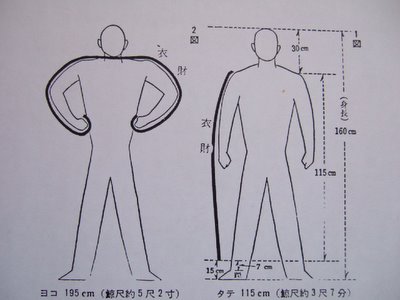


“The larger is three cubits long by five cubits wide (…) it has only seven stripes , each with two long segments and one short segment”
Kesa-Kudoku, Dogen.
To find out the right size of the kesa, one has to measure the distance from the elbow to the tip of the fist ( nigirichu) or the distance from the elbow to the tip of the middle finger ( nobechu) of the person who will wear the kesa. This measurement is called Chu or cubit ( Sanskrit hasta) and means forearm.
Takushu (stretch between thumb and middle finger when the hand is opened) and shi ( the width of the first finger) are also used. The general rule is the following:
24 shi (finger) = 2 takushu ( stretch)= 1 chu ( cubit)
If your nobechu is 43 cm, then the kesa will be:
3 times 43 long (135cm) by 5 times 43 wide ( 215cm ).
This size tends to be generally too big.
If you pick up the nigirichu , 38cm, then you have a kesa which will be 114 long by 190 wide which is …too small.
The method is to go for a chu which is in between: 43+38 divided by 2= 41
3 times 41 long ( 123 ) by 5 times 41 wide ( 205) will be the size of your kesa.
To make things simple, measure your nobechu and find out below which size your kesa should be:
40: 191cm/114cm
41: 198cm/116cm
42: 205cm/121cm
43: 205cm/123cm
44: 212cm/126cm
45: 212cm/129cm
46: 219cm/131cm
47:219cm/134cm
48: 226cm/136cm
49: 233cm/139cm
There is another way, which is expressed in the Hobukukakusho of Mokushitsu Zenji. It is simple, to find out the length of the kesa, one measures the distance from the shoulder to a point which is about 15 cm from the ground. The width is the distance from the fingertips of your hands forming fists. This method is not used by Kodo Sawaki’s disciples because it doesn’t follow Buddha’s instructions as quoted in Kesa-Kudoku Shobogenzo ( 3 chu by 5 chu ).


0 Comments:
Post a Comment
<< Home